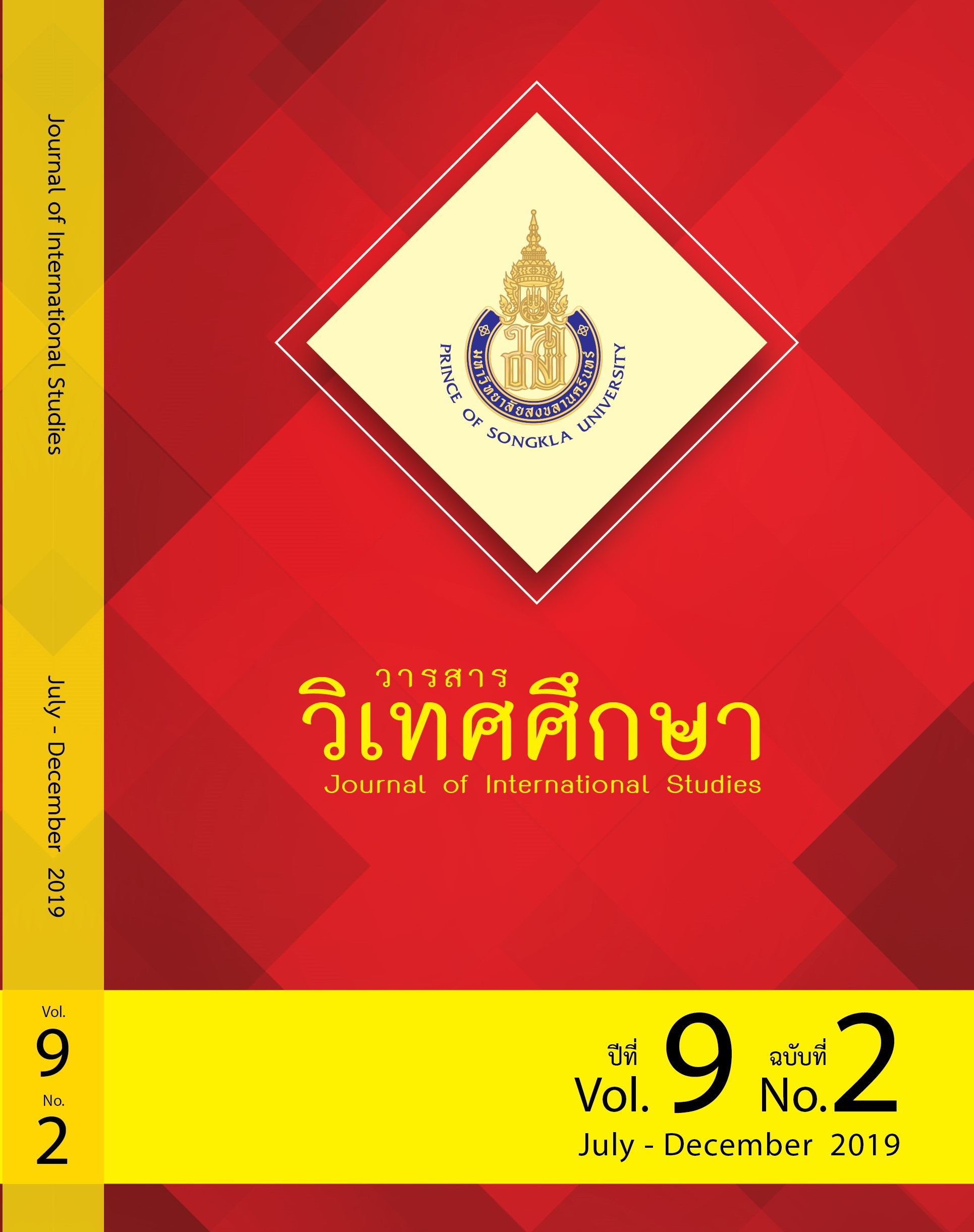Out-of-class English Language Learning and the Communication Skills of University Students
Main Article Content
Abstract
This research is a quantitative and qualitative study.The research objectives were (1) to study the effects of out-of-class language learning on students’ communication skill, and (2) to identify the factors related to out-of-class language learning. The research instruments included questionnaires, personal learning logs, and a communication skill pre-test and post-test. The study was carried out at Mae Fah Luang University, an autonomous university where English is used as a medium of instruction. The participants in the study were ten students who voluntarily participated in out-of-class oral communication development. They were third and fourth-year non-English majors in the 2017 academic year. After 10 weeks of participation in the out-of-class language learning, based on the pre-test and post-test, it was found that students who were more autonomous than other students performed better in their post-test, and their post-test scores were statistically higher at a significance level of 0.05. The main factors affecting communication skill were vocabulary and grammar; and factors influencing out-of-class language learning included motivation and learning context.
Article Details
Statements and opinions expressed in articles herein are those of the authors and do not necessarily reflect the position of the editors or publisher.
Article, information, text, image, etc. which are published in Journal of International Studies, belong to Journal of International Studies. If anybody or any organization would like to use part or whole of them, they must receive written permission from Journal of International Studies before usage.
References
Benson, P. & Lor, W. (1999). Conceptions of language and language learning. System, 27(4), 459-472.
Champakaew, W. (2013). The Effectiveness of Negotiation of Meaning Strategies in Two-way Communication Tasks for Oral Proficiency and Grammatical Development of Higher Education Level Students. Dissertation, Graduate School, Chiang Mai University.
Chin-Yi, Chang, Shu-chen, Liu, and Yi-Nian, Lee (2007). “A Study of Language Learning Strategies Used by College EFL Learners in Taiwan.” Language Learning.
Cohen, A. D. & Macaro, E. (2007). Language Learner Strategies: Thirty Years of Research and Practice. Oxford: Oxford University Press.
Cortina-Pérez, B. & Solano-Tenorio, L. (2014). The effect of using out-of-class contexts on EFL learners: an action research. Calidoscópio, Vol. 11, n. 2, p. 167-177.
Ellis, R. 1994. The study of second language acquisition. Oxford: Oxford University Press.
Gass, S. and Selinker, L. (2008). Second Language Acquisition: An Introductory Course. New York: Routledge.
Hayes, D. (2008). Becoming a teacher of English in Thailand. Language Teaching Research. 12, 4; pp. 47-494.
Hedge, T. (2008). Teaching and Learning in the Language Classroom. Oxford: Oxford University Press.
Hughes, L., Krug, N., and Vye, S. (2011). The Growth of an Out-of-Class Learning Community through Autonomous Socialization at a Self-Access Center. SiSAL Journal. Vol. 2, No. 4, December 2011, 281- 291.
Hurd, S. (2006). Towards a Better Understanding of the Dynamic Role of the Distance Language Learner: Learner perceptions of personality, motivation, roles, and approaches. Distance Education. 27 (3). Retrieved May 11, 2016 from http://www.tandfonline.com/doi/ abs/ 10.1080/01587910600940406
Kampa, K. & Vilina, C. (2017). “Building 21st Century Skill in the Young Learners’ Classroom.” The Language Teacher, 41.6, November. Retrieved January 13, 2018 from http://jalt-publications.org/node/4988/ articles/23992-building-21st-century-skills-young-learners%E2%80%99-classroom-part-two.
Ko, J., Schallert, D. L. and Walters, K. (2003). “Rethinking Scaffolding: Examining Negotiation of Meaning in an ESL Storytelling Task.” TESOL Quarterly, Vol. 37, No. 2.
Krashen, S. D. (1976). Second Language Acquisition and Second Language Learning. Pergamon Press Inc.
Lightbown, P.M., Spada, N. (2006). How Second Languages are Learned. Third edition. Oxford: Oxford University Press.
Manfred, W. (2012). Beliefs and Out-of-class Language Learning of Chinese-speaking ESL Learners in Hong Kong. New Horizon in Education, Vol.60, No.1, May.
Maros, M. & Mat Saad, N. (2016). “The Out-of-class Language Learning Strategies of International Students in Malaysia.” International Journal of Social Sciences, 6(8), 478-486.
McKay, S. L. (2002). Teaching English as an International Language. Oxford University Press.
Oxford, R. (1999). Relationships Between Second Language Learning Strategies and Language Proficiency in the Context of Learner Autonomy and Self-regulation. evista Canaria de Estudios Ingleses, No. 38, pp. 109-126
Phitsuwan, S. (2012). ASEAN Charter: Challenges and Opportunities. Future Challenges toward ASEAN Integration. Electronic Proceeding: Mae Fah Luang University, 29 November-1 December. Retrieved May 14, 2016 from http://mfui c2012.mfu.ac.th/ electronic_ proceeding/1st%20MFUIC%202012%20ELECTRONIC%20PROCEEDING.html
Reinders, H. (2014). Personal Learning Environments for Supporting Out-of-Class Language Learning. English Teaching Forum, November 4.
Sakui, K. & Gaies, S.J. (1999). Investigating Japanese learners’ beliefs about language learning. [Special Issue]. System 27, 473-492.
Thanasoulas, D. (2000). “What is Learner Autonomy and How Can It Be Fostered?” The Internet TESL Journal, Vol. 6, No. 11. Retrieved May 14, 2016 from http://iteslj.org/Articles/Thanasoulas-Autonomy.html
Wiriyachitra, A. (2012). “English Language Teaching and Learning in Thailand in this Decade.” Thai TESOL Focus, 15(1), 4-9.


